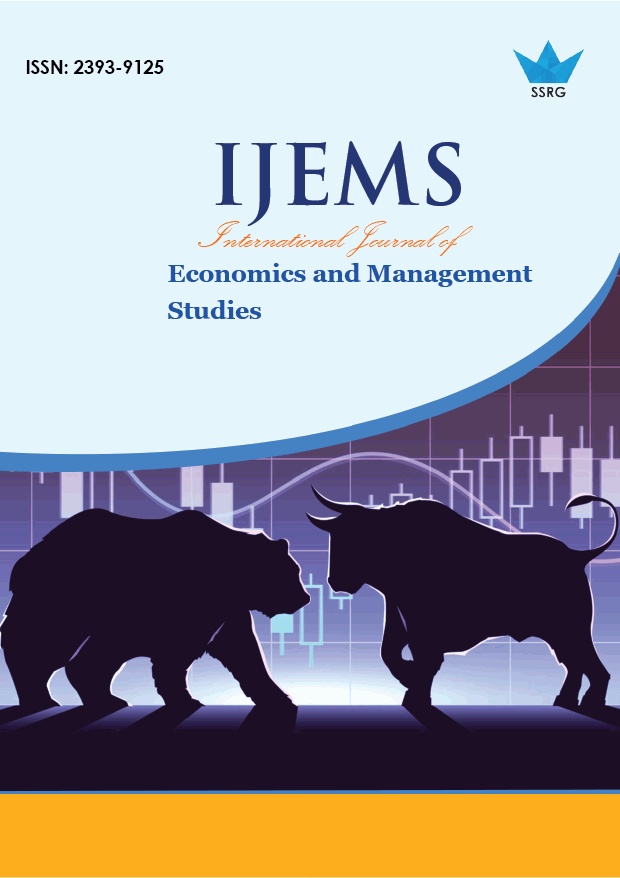Acceptance of HR Analytics Inorganisations

| International Journal of Economics and Management Studies |
| © 2017 by SSRG - IJEMS Journal |
| Volume 4 Issue 7 |
| Year of Publication : 2017 |
| Authors : Neha Singh, Asim Kumar Rajbhar, Sudhakar Puskar |
How to Cite?
Neha Singh, Asim Kumar Rajbhar, Sudhakar Puskar, "Acceptance of HR Analytics Inorganisations," SSRG International Journal of Economics and Management Studies, vol. 4, no. 7, pp. 15-18, 2017. Crossref, https://doi.org/10.14445/23939125/IJEMS-V4I7P104
Abstract:
Organisations nowadays square measure more and more turning into globalised and facing VUCA (vulnerability, uncertainty, quality and ambiguity) within the business setting. below such conditions, creating the proper choices and sustaining competitive advantage square measure the goals of any organisation. Business analytics has emerged as a very important tool to deal with these goals. analysis literature associated reports recommend that application of analytics to manage human resources (HR) in an organisation is smallest. in sight of this, theanalysis is undertaken to check this situation of our analytics within the Indian context and to spot factors that influence the acceptance of analytics among our professionals. This paper discusses the results of thequalitative part that relies on interviews conducted among our professionals.
Keywords:
Analytics in HR, HR analytics, acceptance of HR analytics, Factors persuading acceptance ofanalytics.
References:
1) "Getting smart about your workforce: Why analytics matter.", 2009. [Online]. Available:http://www- 935.ibm.com/services/us/gbs/bus/pdf/getting-smart-aboutyour- workforce_wp_final.pdf. [Accessed: 03- Aug-2014].
2) A.Banerjee,T.BandyopadhyayandP.Acharya,"Dataanalytics: Hypedupaspirationsortruepotential",Vikalpa,vol.38,no. 4, pp. 1 - 11,2013. Levenson, "Using targeted analytics to improve talent decisions", People and Strategy, vol. 34, no. 2, pp. 34 - 43,2011.
3) D. Kiron, R. Shockley, N. Kruschwitz, G. Finch and M. Haydoc, "Analytics: The widening divide", MIT SloanManagementReview,, no. 533, pp. 1 - 22,2011.
4) D.Vesset,B.McDonough,C.W.Olofson,D.Schubmehl,A.Woo dward,S.BondandM.Wardley,"WorldwideBusinessAnalytics Software Forecast, 2015–2019", www.idc.com, 2015. [Online].Available:https://www.idc.com/getdoc.jsp?container Id=257402. [Accessed: 14- Dec-2015].
5) E. E. Lawler III, A. Levenson and J. W. Boudreau, "HR metrics and analytics–uses and impacts", Human ResourcePlanningJournal, vol. 27, no. 4, pp. 27 - 35,2004.
6) E. Lawler and J. W Boudreau, "What makes HR a strategic partner", People and Strategy, vol. 32, no. 1, pp. 14 - 22,2009.
7) HR Joins the Analytics Revolution", 2015. [Online].Available:https://hbr.org/resources/pdfs/comm/visie r/18765_HBR_Visier_Report_July2014.pdf. [Accessed: 11- Sep-2014].
8) J.Harris,E.CraigandD.Light,"Talentandanalytics:newapproac hes,higherROI",JournalofBusinessStrategy,vol.32,no. 6, pp. 4-13,2011.
9) J. Lukić, "The impact of information and communication technology on decision making process in the big dataera", Megatrend revija 11, no. 2, pp. 221 - 234,2014.
10) J.WBoudreau,"TalentshipandHRmeasurementandanalysis:Fr omROItostrategicorganizationalchange",PeopleandStrategy, vol. 29, no. 1, p. 25,2015.
11) K. D. Carlson and M. J. Kavanagh, "HR metrics and workforce analytics", in Human Resource Information Systems:Basicsapplications and future directions., 1st ed., M. J Kavanagh and M. Thite, Ed. Thousand Oaks,CA: Sage Publishing, 2012,pp.150 -174.
12) M. Miles and A. Huberman, Qualitative data analysis. Thousand Oaks: Sage Publications,1994..
13) S. Mondore, S. Douthitt and M. Carson, "Maximizing the impact and effectiveness of HR analyticsto drivebusinessoutcomes", People and Strategy, vol. 34, no. 2, pp. 20-27,2015.
14) S. Pemmaraju, "Converting HR data to business intelligence", Employ. Relat. Today, vol. 34, no. 3, pp. 13- 16,2007.
15) T. H. Davenport, J. Harris and J. Shapiro, "Competing on talent analytics", Harvard Business Review 88, no. 10, pp. 52 -58,2010.
16) T.H. Davenport, and J.G. Harris, “Competing on Analytics: The New Science of Winning”. Harvard Business Press,2007.
17) V.Venkatesh,M.G.Morris,G.B.DavisandF.D.Davis,"Useracce ptanceofinformationtechnology:Towardaunifiedview", MIS Quarterly, vol. 27, no. 3, pp. 425 - 478,2003.

 10.14445/23939125/IJEMS-V4I7P104
10.14445/23939125/IJEMS-V4I7P104